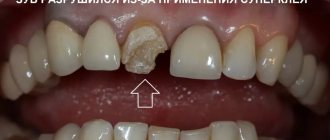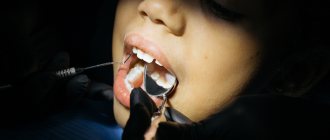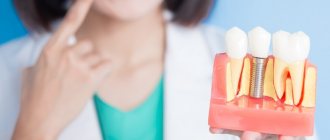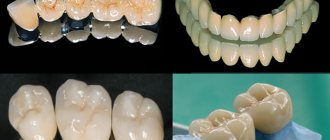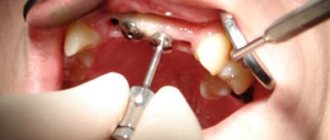Tooth enamel is a protective shell that covers each tooth individually to protect it from various types of damage. Despite the high strength of tooth enamel, it can be destroyed due to mechanical, temperature, bacterial and chemical damage. High-quality oral care will ensure healthy teeth for many years. This article will discuss effective ways to restore tooth enamel at home and using professional methods.
- Remineralization
When can a tooth be restored?
When the walls have completely crumbled, but the root of the tooth has not been destroyed, traditional dentistry sometimes suggests removing it. Today, using new protocols, it is possible to preserve the root and create a new stable unit - any of the functional ones, except for the “eights” (wisdom teeth). To do this, you need the root to be healthy:
- Not affected by caries, without fractures or cracks. If such defects exist, then only removal followed by implantation is indicated.
- No cyst. If there is one, then a method of treatment is selected. And only then can you begin to restore.
If a similar problem happens to you, do not rush to the surgeon. New technologies make it possible to accomplish the previously impossible - to preserve the root of a tooth. What to do in a particular case is decided at the appointment, after diagnosis. The vast majority of patients manage to save the tooth after treatment procedures and install a crown on the root of the tooth.
Are there any disadvantages to the extension procedure?
Of course, no dental procedure is without its downsides. And although extensions on a pin offer great opportunities for restoring damaged teeth, it also has its drawbacks. For example, in rare cases, installing a pin further destroys the tooth. If the doctor makes a mistake in treatment, caries may develop. Finally, the metal raw material for the rod can be damaged by corrosion.
- Tooth root extension
Sometimes pins destroy teeth even more
In some cases, in order to subsequently remove the pin, the entire tooth must be removed. An allergic reaction is another potential disadvantage of the procedure. And, what is most likely, after a certain period of time (depending on your luck), the walls of the tooth become thinner and it collapses. That is, a pin is not a guarantee that the tooth will always be in this form, and no further treatment or prosthetics will be required.
After restoration, teeth will still have to be treated or removed someday
Examples when only the roots of the teeth in the upper jaw remain
Example 1. Restoration from one root of a front tooth
In this example (presented in full here), the situation was created literally by the patient’s hands. She tried to glue part of the tooth with superglue and, under the influence of dangerous substances contained in the glue, the crown of the tooth became completely unusable.
But the root of the tooth under the crown below remained intact and unharmed.
The length of the healthy part of this tooth root removed all doubts about the question - is it necessary to restore the root? Certainly! - it is possible and necessary. The tooth was restored in 1.5 hours using Cerec technology. And here in the photo is the happy owner of a new restored front tooth:
Example 2. Restoring 3 front teeth, of which only the roots remain
Here is a treatment example where I restored the aesthetics of her smile to a 22-year-old girl. The three front teeth on the upper jaw were completely destroyed. From the upper teeth 1.2, 1.1, 2.1 only
the roots
:
These three teeth were actually an aesthetically unsightly frame made from old fillings. Now we will not analyze the whole case in detail, I would like to draw your attention to the following points:
- the shape of the roots of the teeth and their condition made it possible to restore them
- There was no talk at all about any amputation - removal of the roots of the teeth of the upper jaw and implantation.
Our patient's smile was designed in a computer program:
So, in the photo below you see a general set for restoring our patient’s dentition, and among the modules there are 3 with a crown and a root.
The roots of the upper front teeth were quickly and, most importantly, effectively restored:
and our patient underwent a beautiful transformation and became the owner of a sweet and chic smile:
This is the enormous potential and aesthetic power of healthy tooth roots! Don't rush to delete them)
Example 3. Complete restoration of the smile zone on the front teeth of the upper jaw
This example is actually very popular on the Internet, since the patient is a TV presenter, and as a result of the treatment she found her new smile. Which is extremely important for her profession. I describe the detailed clinical case itself in another article, but here I would like to note the main points related specifically to the restoration of the roots of the front teeth with crowns.
In the picture below we have removed composite restorations and carious lesions. only the roots remain of the two front incisor teeth.
:
Crowns and “crown + root” modules were prepared in the laboratory:
After installation, the smile began to shine with bright colors:
You can see the entire chronology of our patient’s treatment in one large picture, step by step:
How to strengthen tooth enamel
Fluoridation
Fluoridation is the most common and only proven effective way to strengthen enamel. It involves applying fluoride-containing compounds to the surface of the teeth.
Penetrating into tooth enamel, fluoride accelerates the absorption of calcium and phosphorus, strengthening and restoring the tooth surface.
It happens like this: fluorine molecules combine with hydroxyapatite, forming hydroxyfluorapatite, a mineral that is resistant to acids. Learn more about the benefits of fluoride
For home care and caries prevention, you can use fluoride toothpastes. The most effective are those containing sodium fluoride and amino fluorides. The higher the fluoride content, the stronger the remineralizing property of the paste and the protection against caries.
The fluoride concentration in toothpaste is measured in ppm or percentage. If the tube says that it contains 900 ppm fluoride, then a kilogram of paste will contain 900 mg of this element.
| Type of pasta | Purpose | Fluoride amount |
| Preventative | For daily use. | up to 1000 ppm |
| Medical | Intensive strengthening of enamel at the first signs of caries. The time of use is limited by the course prescribed by the doctor. | 1000-1500 ppm |
Toothpastes with fluoride
Toothpaste CURAPROX Enzycal 1450
ApaCare Remineralizing Toothpaste
Colgate Elmex Toothpaste Caries Protection
Elgidium toothpaste Protection against caries
Nanohydroxyapatite
Medical nanohydroxyapatite is no different in composition from natural one. Thanks to this, it is easily integrated into the crystal lattice of enamel and solves the following problems.
- Seals microcracks.
- Reduces tooth sensitivity.
- Eliminates caries at the white spot stage.
Toothpastes with hydroxyapatite
Biorepair Total Protection toothpaste 75 ml
miradent mirasensitive hap+ toothpaste for sensitive teeth
Vivax toothpaste. Remineralization.
Dentissimo Complete care toothpaste Complete care
Amorphous calcium phosphate
When in contact with saliva and hydroxyapatite, this element forms a special biofilm on the surface of the teeth, which:
- protects enamel from the harmful effects of acids;
- ensures the connection of bioavailable calcium with enamel, accelerating its remineralization.
Important! Since the active substance is obtained from cow's milk casein, this method of strengthening enamel is not suitable for people with allergies to milk protein.
Gels and toothpastes with amorphous calcium phosphate
Tooth gel GC MI Paste Plus Mint
Tooth gel GC Tooth Mousse Strawberry
Toothpaste Apagard Premio 100 ml
Theobromine
This is the youngest, most innovative way to strengthen enamel using cocoa bean extract. Theobromine stimulates the formation of its own hydroxyapatite crystals in the enamel. Theobromine pastes are produced by Theodent brand.
The remedies listed above can be used at home to prevent and treat minor oral problems.
Why do tooth remains appear in the gums?
There are many reasons for this phenomenon:
- Perhaps the tooth has completely crumbled, but the root remains.
- The crown received a strong blow and a fracture occurred.
- An incomplete tooth extraction was performed. The remaining fragments cause inflammatory processes in the soft tissues, causing pain.
- Units with the neurovascular bundle removed are often destroyed. The so-called “dead teeth”. The nutrition of their walls is disrupted, the shell becomes fragile and, due to incorrect loading or due to increased fragility, the natural walls break off “at the root.”
If the process has already started, then urgent treatment of the tooth root is necessary. Otherwise, the remains of the unit will have to be removed to avoid infection of adjacent teeth and surrounding tissues.
The situation cannot be ignored: tooth fragments may not bother you at first, but then turn into a serious problem. When trouble occurs, immediately contact the dental clinic to promptly select treatment and find ways to restore the tooth.
Loose front teeth
Loose front teeth are a wake-up call. Often this trouble happens with the front teeth. The main cause of looseness is gum disease: periodontal disease, stomatitis, gingivitis. You should not run them, otherwise you may end up without teeth at all.
The doctor will select the treatment for loose teeth individually. If the swaying is accompanied by pain, the teeth deviate significantly to the sides, the dentist applies special splints, removable or non-removable, to the incisors. Splinting strengthens mobile teeth, prevents their loss, and allows periodontal tissues to recover. In severe cases, surgical treatment cannot be avoided. During surgery, the surgeon removes bone tissue or restores it using metal shunts.
Cysts in the tooth canal and granuloma have a bad effect on the roots, and the teeth begin to become loose. These tumors need to be removed. If the tooth begins to loosen after a blow or injury, it is better to go for an x-ray.
Examples of canine restoration when only the root remains of the tooth
Example 4. The pin in the root of the lower tooth was removed, and the canine itself was restored
In this clinical case, I was restoring the lower canine, and the task was to save the root of the tooth and restore the coronal part of the canine, which was almost destroyed by caries. The anterior wall of the lower canine was made in the form of a filling, and it fell apart from the cutting edge.
As you can see in the photo, an anchor pin was installed inside the tooth - this is a pin that is screwed into the canal to strengthen the tooth. The tooth under the filling and the root of the lower canine were affected by caries. When the carious tissue was removed, only the root and a small part of the wall
:
You and I remember the main topic of our article, which tells us the following - if the tooth root remains, it can be completely restored. And this is not the first time that the unique Cerec technology has come to our aid. Using it and digital scanning, we restored the missing tooth module, which also included the root part:
Next, we restore the lower front tooth using a CEREC inlay and get an excellent result - the lower canine is completely restored:
Example 5. The root of the tooth under the crown of the upper canine has not rotted, and therefore the tooth is 100% restored
In this case, there was a total restoration of the dentition (veneers and crowns) with the replacement of worn-out crowns on the front teeth. One of the upper canines under the crown was seriously affected by caries, but its root was practically healthy - only a small part of the tooth root was damaged, see the following photo:
The missing “crown + root” module and new crowns were manufactured in a laboratory. In general, everything is in a smile, it looks just great:
And the owner of a new beautiful smile herself cannot hide her admiration:
All the main tasks in this total work were successfully solved, but the main thing you should pay attention to is that we managed to save the tooth root here too.
Light filling on a pin – what are the advantages of the method?
A post filling is considered a reliable replacement material when a dentist is restoring a fractured unit. A titanium or fiberglass pin is inserted into the root canal, after which the coronal part is restored with a composite material. Among the disadvantages of the method is the potential risk of root fracture, since the pin fails under pressure, as well as shrinkage of the filling and the development of secondary caries under it.
Unfortunately, teeth restored in this way do not last forever. After 3–5 years, the dentist will have to change the filling or, due to global destruction of the crown, perform prosthetics/implantation.
How to determine if a root is healthy
How to understand whether caries has affected the root of the tooth, whether the dentin of the tooth root is intact or whether there are defects? In order to have an objective picture of the process, it is necessary to perform an x-ray of the tooth root and a computed tomogram. A CT scan will determine the true condition of the root and show:
- The presence of inflammatory processes.
- It will determine whether there are neoplasms and what size they are (cyst or granuloma).
- The location of the roots in relation to the neighboring ones, the maxillary sinus.
This is the only way to see whether it will be possible to cure the tooth root using a tab.
Example 6. Restoration of teeth 4 and 5, when only one root remains
In the next total work I would like to highlight the 4th and 5th premolars. In general, the girl’s situation was quite complicated initially at the time she contacted me. Both the lower and upper jaws were restored. Let's look at only the top one.
Front 4 teeth
- these are 1.2, 1.1, 2.1 and 2.2 were entirely made of composite material, under which caries developed. And the teeth we were interested in, 1.4, 1.5, 2.4 and 2.5, were covered with metal-ceramic crowns under which there were metal inlays. Today, such structures are rarely used in advanced dentistry, since the same Cerec technology allows you to achieve excellent results with one module “crown + tooth root”, rather than breaking the structure into an inlay and a crown with an additional adhesive layer. In fact, we place a crown at the root of the tooth with the function of the missing root. There will be a separate example on metal tabs a little later.
So, in the photo below, the crowns were removed, the inlays were removed and carious tissue was removed from teeth 4 and 5, leaving healthy roots
:
If only the root remains of a tooth, this does not mean that it cannot be restored. And let this tooth root be pulpless, i.e. dead - such tooth roots feel great in bone tissue and orthopedic structures can be built on them. Using computer technology and 3D scanning, we first restored virtual teeth:
The following photo shows that on one side we place crowns with an inlay function in place of the 4th and 5th teeth, and on the other opposite side we place half-crowns also with an inlay function.
That is, these are single modular designs - veneers with a root part, which are currently the best for the patient
:
Installing veneers with the root part allows you to completely recreate an aesthetically beautiful dentition:
The stage of temporary prosthetics, which allows the patient to see his smile, plays an important role in the very process of its new formation, since the patient understands that the main problems with the restoration of the remaining teeth, and in fact the roots of the teeth, are left “far behind”:
After installing crowns and half-crowns and restoring the front teeth, our patient’s smile was transformed beyond recognition, the so-called. wow effect:
The clinical example described above can be viewed in detail HERE.
Enamel implantation with Innodent
The procedure is new, but has already proven itself as an effective method for restoring tooth enamel .
- Painlessly cures caries in 1 month
- Relieves tooth sensitivity
- Removes white spots after braces
- Strengthens and mineralizes enamel
Description of the procedure:
Innodent is applied to the tooth surface, which in turn is integrated into the enamel structure at the molecular level. This is achieved through active substances whose characteristics coincide with dental tissues.
Main results:
Cracks and damage to the enamel are completely eliminated, the integrity of the tooth enamel is restored and the process of regeneration of the natural structure begins.
When will the results of the procedure be visible?
You will see the first results 3 days after the start of the procedure, but the process of tooth enamel regeneration itself can last 1-1.5 months. A decrease in the sensitivity of enamel to mechanical and temperature stimuli also occurs gradually. In individual cases, it is possible to re-use the drug after 3-4 months.
Indications for the dental enamel implantation procedure
Below we will describe the main indications for which enamel implantation will be the most effective restoration method.
- High sensitivity of teeth (temperature and mechanical)
- Damage (chips) and cracks in tooth enamel
- Wedge-shaped defect (hyperplasia)
- Tendency of teeth to the spread of caries
- Pigment spots on the surface of tooth enamel
- At the initial stage of caries spread
An important feature of the drug is the possibility of use for preventive purposes, as well as in conjunction with teeth whitening procedures. Effectively copes with the treatment of enamel demineralization. It is possible to carry out the procedure after correction with braces in order to eliminate age spots on the surface of the enamel.
Are there any contraindications to the procedure?
The procedure is completely safe and has no contraindications as such. However, in rare cases, the following are possible: an allergic reaction and individual intolerance to one or more components of Innodent. You should not carry out the procedure with major damage to the internal tissues of the tooth.
Pros and cons of dental enamel implantation with Innodent
Main advantages:
- High degree of safety and natural ingredients
- Suitable for pregnant women and children (including baby teeth)
- As a result, you get smooth enamel with a natural shade
- Stains and damage are completely eliminated within a month
- Can be used at the initial stage of caries development and thereby avoid drilling and filling teeth
- Complete painlessness and absence of discomfort for the patient at all stages of the procedure
- The procedure is quick - about 15-25 minutes for everything
- The result lasts really long (from 1 to 3 years)
Flaws:
- Price - the method is not the cheapest, but in terms of price-quality ratio it has no analogues
- Really good results are possible a month after the procedure
- Does not solve the problem with large defects (internal tooth decay)
Dental implantation with the help of Innodent has allowed modern dentistry to truly restore enamel, and not replace it with temporary solutions.
A completely new approach to enamel restoration
Why removing the root is not the solution to the problem
If there is no natural crown, and instead of it an empty space appears, especially when it is the roots of the upper front teeth, many people habitually rush to the surgeon. They want to remove the remains and quickly install a bridge, eliminating the aesthetic defect.
But first, it’s worth considering the situation with your doctor - there are certain risks during removal: damage to the mandibular nerve, excessive trauma to the gums, and others. In addition, tooth restoration based on its own root is always more gentle than any prosthetic method.
Dentists try to preserve every unit, since the absence of natural teeth leads to a decrease in the quality of life. If you simply remove the roots of permanent teeth, then immediate implantation is needed. In the absence of a unit, destructive processes begin in tissues, and bone volume decreases. Therefore, doctors do not recommend neglecting this problem. Even if there is no chewing molar, which is not visible.
What to do with a thin protective shell
In case of damage or genetic predisposition, there is no need to be upset. We will have to strengthen control and care of the oral cavity in order to prevent the development of pathological processes and long-term treatment, but there is nothing terrible about it. Follow a few basic principles that will help keep your smile beautiful and your teeth healthy:
- stop eating solid foods;
- visit the dentist at least once every six months;
- carry out professional fluoridation;
- use remineralizing agents twice a day as prescribed by your doctor;
- stick to a diet, eat more vegetables, fruits and healthy foods.
To prolong the beauty of a smile, it is enough to increase attention and care. This will not take much time, but will prevent further tooth thinning and damage.
Examples of restoration of fifth teeth on the upper and lower jaws
Example 7. A metal tab and caries left only the root of the 5th tooth
A patient came to me with a 3.5 tooth. It was a pulpless tooth - the lower five, it did not have any periapical changes or inflammation in the area of the root apex. The tooth was missing the upper half of the crown part of the tooth. This tooth 3.5 initially had a filling, a metal stump insert was installed in the tooth, quite deep, and a filling was already installed on top. Here's a “puff sandwich”:
As I said in the previous example No. 6, metal tabs are beginning to be used less and less in practice - they have been replaced by modern computer technologies, for example, Cerec. As a result of the atraumatic removal of the metal insert, the bone was preserved, nothing cracked: neither the root nor the remaining bone structure:
The restoration of the bottom five was carried out using Cerec technology in 1.5 hours
:
The “crown + root” module fell into place perfectly, the patient was very pleased with such a quick and effective solution to his problem:
Example 8. The top five were completely destroyed by caries. But the tooth root survived
With this example, I want to show you how deep caries can literally “eat” your teeth. And, of course, try to prevent it from developing like this. The patient is a fairly young man who has decided to radically improve his image. This is a laudable decision, but here are the teeth he came to me with:
Caries on almost all teeth. After removing the carious layer, the remains of the teeth appeared in this form:
Please note that in place of the upper tooth 5
There was practically only one root left with a small side wall. In this case, the same technology of tooth restoration using the “crown + root” module and crowns/half-crowns with an inlay function was used. The result of the treatment, as they say, is on the face:
The goal of treatment, according to the patient, has been fully achieved - a brutal Man
:
Is it possible to completely restore enamel on your own?
Contrary to the fact that many want to see a positive answer in this section, there will not be one. If the coating began to deteriorate, then there were contributing factors, which do not always depend on whether the person cracked nuts with his teeth or not. You can only partially slow down this process before you can visit the dentist’s office and take drastic measures.
For protection, doctors offer the thinnest veneers. They are not felt in the mouth, do not bring the slightest discomfort, but at the same time, ceramics prevent microorganisms from reaching the protective shell and penetrating deep into the crown. In addition, the doctor can coat the dental plates with a fluoridating or remineralizing composition, which will prevent destruction for a long time. Therefore, to the question: how and whether it is possible to restore enamel on teeth at all, the answer will only be denial.
When and how can you restore a tooth with Cerec?
A common problem is the development of caries on the frontal units. The result is their complete destruction. The patient sometimes comes too late. Or the previous intervention does not bring the desired result. When several units in the smile area are damaged, and some of them only have tooth root tissue left, you can combine the installation of crowns, veneers and restoration of the upper visible part using special inlays in the root system. Sometimes large-scale intervention is needed - the smile area is corrected, damaged teeth are recreated. You can do a step-by-step restoration of 10 or even 20 teeth above and below.
Using Cerec technology, if there is a healthy root, it is easy to restore almost every tooth within a few hours.
- It will be necessary to determine the condition of the root and undergo a course of treatment.
- Then, after treating the upper roots, it is possible to install a module with the alignment of the tooth crown and the insert into the cavity in the tooth root.
A smile should always be charming. When restored, the new units are ideal, better than natural ones. In addition, natural teeth darken under the influence of pigments or turn yellow with age. Therefore, next to the restored ones they look unaesthetic.
To avoid such consequences, units can be corrected with veneers or crowns (when they are 50% destroyed and there is no stable support). To create an impeccable beauty zone thanks to Cerec, you only need a few visits to the doctor.
Advantages of dental restoration with crowns
Crowns have a number of advantages:
- The installation of such dentures protects the tooth from further destruction much better than a conventional filling on a pin.
- The crowns are very durable and can withstand loads that are significantly more intense than when chewing food.
- Unlike filling material, crowns do not change color during use and do not suffer from food acids and other substances.
- A correctly manufactured and installed crown will allow the damaged tooth to be used for many years to come.
Features of Cerec technology
Cerec root inserts and crowns are made from metal-free materials - it can be ceramic or zirconium dioxide. They can be installed even for allergy sufferers without fear. This technology has completely changed traditional approaches to dentistry.
Now the restoration process is comfortable and takes a minimum of time. In my clinic, the procedure is carried out in several stages.
I would also like to note that only one anesthesia is required and there are practically no errors when creating new teeth. Stages:
- An intraoral scanner determines the boundaries of the damage. This is especially important when only the roots of the front teeth or molars remain. The remaining tissues, antagonist teeth, and closed rows are scanned.
- The information is transferred to a computer, where all the images are combined into an image.
- The program creates a three-dimensional model of the remaining tooth, all defects are clearly visible. Then models of the inlay and crown are created that perfectly replicate the anatomical features of the tooth. Dimensions and shape are calculated accurately. It is determined what kind of restoration is needed.
- The design is made from blanks on a milling module. The elements are being tried on. In rare cases, correction is required. Shade discrepancies or other issues that displease the patient can be easily corrected within a few minutes.
- The completed root inlay fits hermetically to the remaining parts of the tooth, is securely fixed and exactly matches the shape.
Thus, it is possible to quickly restore units if only the roots of the teeth of the lower or upper jaw remain.
Prevention measures
- Careful hygiene at home - at least twice a day, every day
- Clinic visits for professional cleaning – once or twice a year
- Eating foods high in vitamins and minerals
- Reducing intake of high carbohydrate foods
- Avoiding carbonated sugary drinks
- Timely treatment of dental and periodontal diseases
The network of dental clinics “Smile” offers services for restoring tooth enamel. Contacting our specialists has a number of undeniable advantages:
- treatment by highly qualified doctors;
- compliance with treatment protocols that meet international standards;
- family and savings discounts;
- transparent pricing;
- Convenient work schedule: daily until 21:00 (Sunday until 16:00).
You can make an appointment at any of the branches of our clinic in Moscow, located within walking distance from metro stations:
- Art. Alekseevskaya (VDNKh district, etc. Mira), address: st. 3rd Mytishchiskaya house 3, building 2;
- Art. Shelepikha, address: Shelepikhinskaya embankment, address: building 34, building 1.
The high qualifications of our specialists and modern equipment allow us to solve the problem of restoring enamel at any stage of destruction. We guarantee the effectiveness of treatment and the safety of the methods used. Your health is in good hands!
Benefits of Cerec Restoration
The innovation has clear advantages compared to traditional prosthetics:
- The process does not take a week or several days, but only 1.5 hours
per tooth maximum. - Accuracy
. The computer minimizes errors and eliminates errors. - Biocompatibility
. Fabrics do not reject materials.
An inlay in the tooth root is created quickly, then the crown is modeled. The price is fully justified by the reliability, long service life of the structures and their aesthetics.
There is a striking difference between the smiles of patients when they only had the root of the tooth left, and the photo after treatment with Cerec dentures.
Why does a tooth hurt after installing a pin?
Of course, pain in the area of the treated tooth is by no means a necessary phenomenon. But no one is safe from it, so you should be prepared for such unpleasant moments. Do not be afraid if for some time, literally a couple of hours after a visit to the doctor, the tooth begins to sag, as do the gums. However, during treatment, the tissues of the tooth and gums are affected; they are somehow, within the permissible limits, injured. Therefore, tolerable pain that does not last for several days is quite possible, there is nothing terrible about it.
After restoration, teeth may hurt a little
You can drink a packet of Nimesil, which will relieve discomfort.
Nimesil
If the pulp was removed during dental procedures, the pain may last for several days. Over time she will calm down. If nothing has changed, rush to the doctor. Prolonged pain may also indicate an allergic reaction to the material, which is also possible, and this also requires an early visit to the clinic.
Example 9. Restoring the bottom six “from the root”
In this case, I would like to simply dwell on the moment of restoration itself. The patient is older, over 50 years old. And he felt the need to restore the chewing group of teeth. The picture shows the lower 6th tooth, of which practically only one root remains:
The tooth was restored in 1.5 hours
using Cerec technology. The very speed of tooth restoration in one visit to the doctor and the patient’s ability to immediately, as they say, use it in chewing gives a 100% head start on any existing method of tooth restoration. It works really well - you can see for yourself.
Example 10. Restoring the bottom seven
And I end my examples with the classic option of restoring the seventh lower tooth, of which only the root part remains. Removal of the lower 7th root of the tooth was not required; Cerec technology again proved to be excellent:
After modeling in 3D, manufacturing the module itself only took about 20 minutes, after which it was successfully installed on the remaining root:
Restoration methods for the initial stage of destruction
Restoration of tooth enamel is the implementation of measures aimed at reconstructing the appearance of the enamel layer and restoring the protective functions it performs.
It is performed using various methods depending on the condition of the enamel. The earlier measures are taken, the better the effect. When initial symptoms appear, the following measures are effective:
- professional hardware teeth cleaning;
- remineralization – saturation of enamel with essential minerals, including fluoridation (coating teeth with a special varnish).
Note: it is impossible to restore enamel at home. The patient can only help the doctor. To do this, he must review his diet, carefully carry out hygienic dental care, eradicate bad habits, and begin treating systemic diseases (if any).
Should the tooth root be removed? In what cases is this necessary?
Is it necessary to remove the root of a tooth? The root must be removed if:
- it is mobile, unstable or has a deep pocket;
- there are cracks;
- the root processes are “recessed” into the bone tissue and are located below their level;
- root tissue is softened or severely destroyed;
- There are chips in the tooth root.
Modern surgery is as painless as possible. Doctors perform the procedure while maintaining the integrity of the surrounding tissue. In the absence of inflammatory processes, it is possible to remove the real tooth root with simultaneous implantation of an artificial one.
CONCLUSIONS:
As you can see from the examples provided, I, orthopedic dentist Sergei Samsakov, an expert in the field of digital modeling and restoration of teeth using Cerec, manage to restore a beautiful smile even in almost the most hopeless cases. If you have similar problems, do not hesitate, contact us, and we will always find the optimal and, most importantly, beautiful solution to your situation.
And remember the simple truth: there are no hopeless situations!
